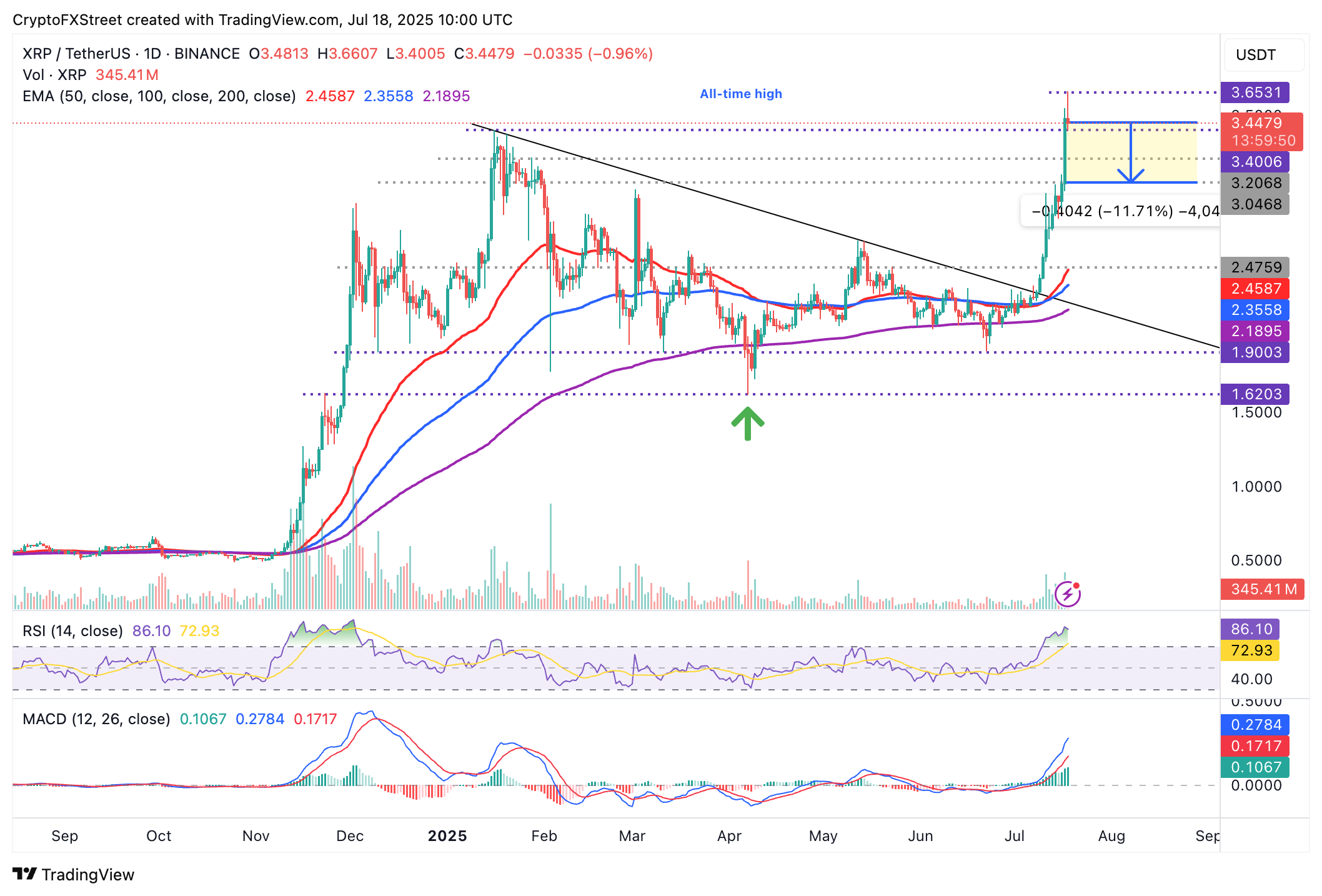XRP price strikes new all-time high as CEO Brad Garlinghouse hails GENIUS Act passage
- XRP price rallies on Friday, setting a new record high of $3.66 before retracing slightly.
- Ripple CEO Brad Garlinghouse called the passage of the GENIUS Act historic, cementing the US as a leader in innovative financial technology.
- Despite the price surge, XRP spot volume remains neutral, suggesting room for further upside.
Ripple (XRP) surged aggressively to a new all-time high of $3.66 before pulling back slightly to $3.44 on Friday. Investors increased their exposure to the cross-border money remittance token, following the passage of three crypto bills in the United States (US) House of Representatives on Thursday.
The Guiding and Establishing National Innovation for US Stablecoins Act (GENIUS Act), the Digital Asset Market CLARITY Act (CLARITY Act) and the Anti-Central Bank Digital Currency Surveillance State Act (Anti-CBDC Act) all passed the House vote, potentially paving the way for clear cryptocurrency regulations in the US.
XRP offers signs of extending the rally after passage of key crypto bills
Ripple’s CEO, Brad Garlinghouse, has lauded the passage of the crypto bills, saying via a post on X that “the signing of the GENIUS Act cements the US’s future in being a leader in truly innovative financial technology – stablecoins.”
Apart from XRP, Ripple issues RLUSD, a regulatory-compliant stablecoin designed primarily for institutions. RLUSD is the 16th-largest stablecoin, boasting a market capitalization of $517 million.
The GENIUS Act is expected to establish a clear regulatory framework for stablecoins at both the federal and state government levels, thereby setting the stage for digital financial technology innovation in the US.
Ripple’s CTO, Stuart Alderoty, also hailed the passage of the GENIUS Act, which heads to US President Donald Trump’s desk for signing, saying that “at long last, there’s movement on workable, clear frameworks for crypto and stablecoins that will both foster innovation and protect consumers.”
Ripple has been working to establish its stablecoin infrastructure, aiming to be competitive with the Global SWIFT system. In June, Garlinghouse stated that the XRP Ledger (XRPL) could capture 14% of SWIFT’s liquidity, serving as a conduit between the traditional financial system and the digital asset economy.
Technical outlook: XRP could extend the price discovery phase
XRP price is currently trading at around $3.44, up slightly on the day at the time of writing. The token tagged a new record high of $3.66, underscoring increasing demand for both retail and institutional investors.
A Golden Cross pattern on the daily chart validated when the 50-day Exponential Moving Average (EMA) crossed above the 100-day EMA on July 11, cementing the bullish grip.
Additionally, a buy signal maintained by the Moving Average Convergence Divergence (MACD) indicator since June 28 has emboldened risk-on sentiment, calling on traders to increase their exposure.
A daily close above $3.50 could help ascertain the uptrend’s strength. If XRP breaks above the current all-time high of $3.66, a fresh price discovery phase could boost the token higher.

XRP/USDT daily chart
Despite the run-up to new record highs, volume in the spot market remains neutral, indicating that conditions are still favorable for XRP to extend its bullish leg to new levels, targeting $4.00 in the short term.
-1752849493280.png)
XRP Spot Volume Bubble Map: Source: CryptoQuant
Meanwhile, the extremely overbought Relative Strength Index (RSI) at 86 signals the possibility of a trend correction, especially if profit-taking activities increase, overshadowing demand. The previous record high at $3.40 serves as tentative support, but if broken, traders will look for support at $3.00, which was tested in early March as resistance, and $2.80, which was tested as support on Tuesday.
Cryptocurrency prices FAQs
Token launches influence demand and adoption among market participants. Listings on crypto exchanges deepen the liquidity for an asset and add new participants to an asset’s network. This is typically bullish for a digital asset.
A hack is an event in which an attacker captures a large volume of the asset from a DeFi bridge or hot wallet of an exchange or any other crypto platform via exploits, bugs or other methods. The exploiter then transfers these tokens out of the exchange platforms to ultimately sell or swap the assets for other cryptocurrencies or stablecoins. Such events often involve an en masse panic triggering a sell-off in the affected assets.
Macroeconomic events like the US Federal Reserve’s decision on interest rates influence crypto assets mainly through the direct impact they have on the US Dollar. An increase in interest rate typically negatively influences Bitcoin and altcoin prices, and vice versa. If the US Dollar index declines, risk assets and associated leverage for trading gets cheaper, in turn driving crypto prices higher.
Halvings are typically considered bullish events as they slash the block reward in half for miners, constricting the supply of the asset. At consistent demand if the supply reduces, the asset’s price climbs.

